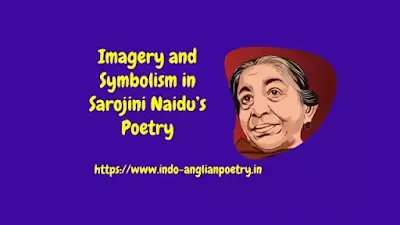Images Used by Sarojini Naidu in Her Poetry:
Sarojini Naidu's poetry abounds in images and these images are varied and sublime. Here are a few examples—Over the city bridge Night comes majestically, borne like a queen to a sumptuous festival (Nightfall in the City of Hyderabad), in The Indian Gipsy, quick Night descends like a black panther from the caves of sleep. The queen laughs, in Queen's Rival, like a tremulous rose and the tissues of veil glow with the hues of a lapwing's crest, and the two-spring baby running to her knee like a wildwood fay.
 |
| Imagery and Symbolism in Sarojini Naidu’s Poetry |
In On Juhu Sands the young moonlight falls like a golden rose on the sea's breast. In Praise of Gulmohur Blossoms presents a feast of the glimmering red of a bridal robe, the rich red of a wild bird's wing, mystic blaze of the gem that burns on the brow of the serpent King, and the blood that poured from a thousand breast to succour a Rajput queen. In the Golden Cassia we have two vivid and picturesque images, the one of the rapturous lights that leaps to heaven from a true wife's funeral pyre and the other of the beloved's heart gliding into the lover's fingers like a serpent to the calling voice of the flute. We have two kinds of images in Palanquin-Bearers, one, vivid, visual images executed with gnomic terseness, like a bird skimming on the foam of a stream, a beam springing on the brow of the tide, and a tear falling from the eyes of a bride, and the second, vague ones, as vague as those of the pre-Raphaelites, like the maiden floating like a laugh from the lips of a dream, swaying like flower in the wind of a song and hanging like star in the dew of a song.
The images of the dance of the wild foam's glee in Coromandel Fishers is reminiscent of Wordsworth's “the waves beside them danced but they (the daffodils) outdid the sparkling waves in glee." The other images from the same poem, "the blue of the verge, where the low sky mates with the sea", is, indeed, apt and wonderful.
Impressionistic images are introduced in the Indian Love Song where morning shows her tents of gold in fields of ivory, in the Cradle Song where the fire-flies dance through the fairy neem and in To the God of Pain where the gem-like fires of hopes upleap like the light of the dawn.
The kinesthetic image (an image of motion or sensation) is found in the "moonlight chill" in The Indian Weavers. Other examples of the kinesthetic images (image and motion seen) are in "the dance of the dew on the wings of a moonbeam" in The Joy of the Spring Time and "fireflies weaving aerial dance" in A Song in Spring.
The following two images from Leili and To India:
“A castle mark on the azure brows of Heaven
The golden moon burns sacred, solemn, bright.” — (Leili)
“And, like a bride high-mated with the spheres
Beget new glories from thy ageless womb.” — (To India)
Symbolism:
Mrs. Naidu is a symbolist and the symbols she has employed are startling. Her poem The Lotus is symbolic. It is a symbol of the Mahatma (Gandhi) with all his sacredness and sublimity and it embodies the poet's whole being in the process of the creative act. In "slumbering sedges" of Solitude that "catch from the stars some high tone of their mystical speech" and the gipsy girl of The Indian Gipsy, who is twin-born with primal mysteries and drinks of life at Time's forgotten source, we sense a symbolic touch. The gipsy girl makes us feel and realize something of the primal mysteries and the ancientness of Time. The serpents of The Festival of Serpents fill us with a sense of wonder and apprehension of some felt-mystery, when we read that they are seers and symbols of the ancient silence, where life and death and ecstasy are all one; we have a similar experience on reading "the mystic voices singing in silence and the winds, dancing and swooning at the holy feet of Night in Leili." The chanting of the name, Govinda, Govinda in Song of Radha, the Milk-Maid reverberates (echoes and reechoes) with the ancient experience of fulfilment in identity (identity or merger with the Beloved) and with yearning of the eternal feminine for the eternal masculine.
General Observation:
Her images and symbols are mostly drawn from Nature, legend, myth, history, country scenes and from the fairy kingdoms which are far removed from our work-a-day world. They are like the dance of the dew on the wings of a moon-beam, or the veil glowing with the hues of a lapwing's crest. They confirm the fact that she is a poetess of high poetic sensibility and delicate imagination; they reveal that her poetry is ornate and that it abounds in a luxuriant feast of similes, metaphors and images. Her Palanquin-Bearers, The Snake-charmer and Humayun to Zobeida are nothing but a kind of crowd of images assembled together. They point out to the spontaneity of Sarojini and her gift for the spontaneous perception of similarity in the dissimilar. Her poetry may not make us, think but she makes us see the scene realized in colours and tunes, they be- speak her extraordinary creative energy and variety of cadences, melody in diction and richness of imagery and symbols. A neo-modernist may regard her diction unrealistic and her imagery as merely fanciful, but in so doing he forgets that she was a singer by birth and aptitude and not by vocation. The images and symbols employed by her seem to have appeared to adorn in her poems of their own accord, and not through a deliberate effort on her part to drag them in.
